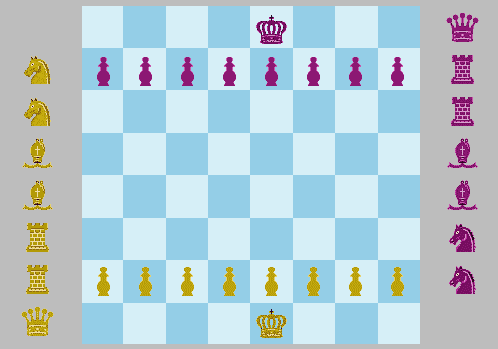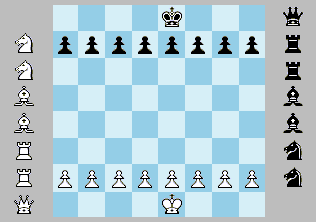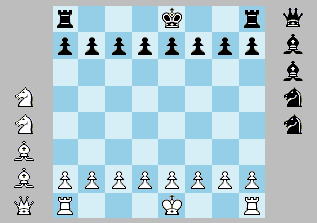

In New Chess the rules are the same as in orthodox chess, except that pieces are placed in the reserve, while the pawns, as usual, are placed on the second row. The king is placed on its regular square. Players may either move a piece or pawn, or drop a piece from the reserve. Pieces may only be dropped on the first four ranks, or on a friendly pawn. In the latter case the removed friendly pawn must immediately be relocated to an empty position, but not beyond the fourth rank, and not on the first rank. The two bishops must be dropped on different colours. Castling can be performed with a rook on a corner square. Note that pieces and pawns are allowed to move before all pieces have been dropped. There are two variants of New Chess: (1) rooks are exterior, (2) rooks are already placed on the corner positions:


Discussion
In this game the variance, and possible developments, are immense. The variant with rooks already placed is more conservative (and perhaps also the best), but both variants are serious forms of chess that put great demands on the players, both strategically and tactically. In the variant with exterior rooks, one would think that it's too easy to get an open file for a rook. But the opponent can always plug up the file by a pawn relocation, and the rook risks becoming an object of attack.
Since the pawns are placed on the board from the start, the dropping phase is shorter than in other drop variants. Thanks to the pawn relocation procedure, there is great freedom in the placement of the pawns, anyway. This also implies that the pieces in the reserve have recourse to the positions where the pawns are located. Note that you are not allowed to make a pawn-relocation if in check. In the opening phase, the same pawn can be relocated several times, by dropping pieces on it. Use the pawn-relocation procedure to speed up development. Keep the pawns in the centre, because center pawns are valuable.
Don't expect that early attacks will be fruitful. The possibilities of defense, and counter-attack, are vast. Castling is a good idea, also in New Chess. Not only does it remove the king from the centre, it also gives protection to the corner area. Don't wait too long before dropping all pieces.
New Chess was invented and implemented by undersigned, June 2006. It was designed to solve the problem of opening monotony in orthodox chess. See also Meteoric Chess.
• You can download my free New Chess program here (updated 2007-02-09), but you must own the software Zillions of Games to be able to run it.
• Try playing 'New Chess' by e-mail, against a human opponent, here.
• Don't miss my other chess variants.
© M. Winther 2006